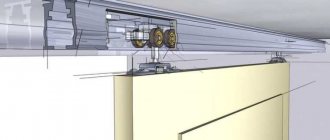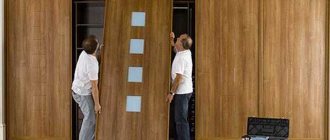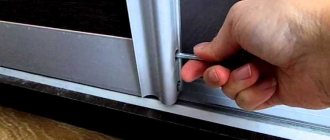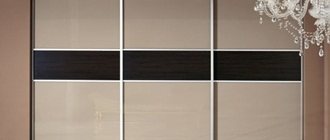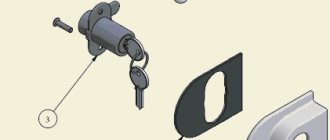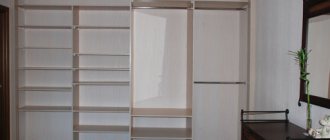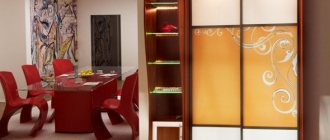0
38831
A sliding wardrobe is a sought-after design for every living space. It is designed to store a really large number of items. Cabinets are made of different materials, have different sizes, and can also have different contents, due to which many things, clothes, accessories or other items can be conveniently placed on shelves and in different compartments. The doors in the design are sliding, and for their comfortable use, guides for sliding wardrobes must be used, along which rollers move, due to which silent opening or closing is carried out.
Functional purpose of guides
The mechanism of sliding doors or a wardrobe consists of a set of basic elements:
- guide profiles – hold the canvas vertically and set the direction of movement of the rollers,
- rollers provide a quiet, smooth ride,
- clamps limit the movement of the door leaf.
Additionally, the kits include: closers for smooth closing of the door, contour and wall frames, locks, handles, seals and brushes that disguise decorative additions.
Rollers for wardrobes
Purpose and equipment
Guides designed for sliding wardrobe doors perform an important function, since it is through them that the free, quiet and easy opening or closing of cabinet doors is ensured. The basis of this design is the rails along which the doors move in a horizontal position. Additionally, the composition includes the following elements:
- pendants or supports;
- profile seals;
- special reliable fasteners;
- small fittings;
- other items that ensure reliable fastening and ease of use of guides for sliding wardrobes.
Versailles cabinets are equipped with reliable, high-quality and durable components, and they also have special baskets for storing small items, which is why such furniture models are considered in demand. The rails with which cabinets are equipped are represented by metal or plastic profiles, which are additionally equipped with various additional elements, namely different rollers, seals, stoppers or other elements. Due to such an unusual and complex design of cabinet guides, the possibility of doors rolling down or warping is prevented.
The width and other parameters of the guides for each cabinet door depend entirely on the dimensions, weight or other characteristics of the door leaves, and also take into account the material from which they are formed and the method by which they are opened. Typically, guides for sliding doors are sold complete with the wardrobe itself, so there is no need to purchase them separately, but if during operation any elements fail, they can be replaced with new parts.
Due to properly fixed door guides, the ability to open or close the door leaf in one plane is guaranteed. Together with other elements, a special system is formed, and it must meet certain requirements:
- high strength, ensuring a long service life of the structure with regular use of the cabinet for its intended purpose;
- attractive appearance that matches the furniture and style of the room where the cabinet is installed;
- ease of use, which is especially important for every user who should not have any difficulties opening or closing cabinet doors.
If you choose guides that meet the above requirements, they will last a long time without causing any trouble to users.
The configuration of the system is considered quite simple, and it is used in the Versailles cabinet model, which has numerous drawers, baskets and other filling systems. The sliding system includes the following elements:
- guides at the top and bottom, and it is along them that the door leaf moves;
- profiles located horizontally and vertically, with each guide profile ensuring reliable retention of the filling;
- a system consisting of upper and lower rollers that guarantee fast, silent and free movement of the doors;
- closers ensuring smooth running;
- silicone seal
- brushes;
- mounting screws;
- stops, presented in the form of spring brackets, and they are the ones that secure the door well in a specific place.
Thus, the structure consists of several different elements, each of which performs its own role.
Sealant
Compartment door diagram
Installation method
The design of the sliding mechanism determines the type of guide and installation method.
Suspension
Suspended - the main profile along which the rollers move is fixed on the upper horizontal surface or on the walls.
An auxiliary profile can be installed on the floor to limit the lateral movement of the door, rattling and hitting the door leaves against each other.
Advantages:
- since the suspension system uses lightweight doors, it is possible to attach the roller system directly to the door leaf;
- savings on frameless installation;
- silent movement;
- easy installation.
Sliding doors with a hanging system
Disadvantage - the method is only suitable for lightweight doors.
Difficulty arises only in the case of installation of glass sections in which holes are drilled for fasteners
Support
Support - a guide profile for the rollers is attached to the floor, and an auxiliary one is installed on the ceiling.
The advantage is the ability to use canvas of any weight.
Flaws:
- open lower profile requires frequent removal of dust and debris;
- The hidden bottom guide complicates installation.
To prevent the threshold from interfering, you can install the lower profile flush with the floor, but this violates the integrity of the floor.
Cabinet structure with support rail system
Guide material
Considering that you are making a purchase for more than one year, it will be useful to know about some of the features of certain materials that are used to make the mechanism. Typically used: plastic, aluminum, steel.
- The best quality guides are made from aluminum. Such products can even be classified as “premium” for their high quality and reliability. This material is considered indispensable if the cabinet is heavy and has a height of more than 4 meters.
- Guides made of steel will cost a little less, but if you choose the thickness and other design parameters wisely, they are not inferior in strength to the previous analogue.
- The most budget option is a plastic guide mechanism. There are many polar opinions about whether such systems are reliable or not, but, in our experience, they can claim reliability in combination with metal elements.
Types of sliding wardrobe guides
There are two options for coupling guides and rollers:
- with a longitudinal groove along which rollers move;
- rail type, when the groove is on rollers.
The variety of shapes satisfies the aesthetic requirements for the sliding mechanism:
- open type - U and W-shaped cut shapes do not hide the rollers from view;
- hidden type - the profile cut has the shape of a spiral, here the groove and rollers are inside the guide, so they are not visible.
Open profiles accumulate dust, which leads to rapid wear of the wheels.
The relative position and number of doors, as well as the shape of the sliding wardrobe determine the choice:
- compartments – the lower one is supporting, the upper one holds the façade vertically;
- sliding - the doors do not change places, the profile is narrow, the mechanism takes up little space;
- cascade - multi-channel movement of the sashes, the facade takes up a lot of space;
- movement of the shutters along the circumference - curved rails are made to order complete with the door;
- books and accordions - folding doors move along a monochannel profile, most often these are hinged structures.
The mechanism of the wardrobe built into the niche pushes the door leaf into the wall, freeing up useful space. Top, bottom, and sometimes middle guides are used, built into a cassette frame inside the wall where the open door is placed.
When choosing any guide, its features are taken into account
Conditional classification
All of these systems include two or more movable door panels. And if we talk about fittings and types of fastenings, then such systems are divided into:
- moving along the wall;
- driving into a niche in the wall.
Let's sum it up
By purchasing a wardrobe, as shown in the photo, you can significantly save space in a small room. Therefore, such designs have been very popular lately. Such systems have different classifications and differ from one another in certain features that must be taken into account before choosing one or another option.
Materials
Plastic
Plastic models are cheap, lightweight, the movement of the rollers on them is silent, and they are used in combination with metal parts. Disadvantages: cracks appear under the weight of the canvas and short service life.
Plastic - used in combination with lightweight facade panels made of plastic and fiberboard, for example, in country cabinets or utility rooms.
Plastic guides
Steel
Steel alloys are inexpensive but heavy materials
To avoid making the wardrobe design heavier, manufacturers produce thin-walled options. Therefore, when choosing a steel option, you need to calculate the correspondence between their thickness and the weight of the blade.
The likelihood of deformation and twisting of thin-walled steel sheets under the disproportionate weight of the blade is high, and sliding quickly becomes less than perfect.
Steel guides
Aluminum
Aluminum alloys have properties most suitable for sliding wardrobes.
- Complex shapes are not deformed during operation.
- The material is light in weight, models of any width do not weigh down the cabinet.
- Made of aluminum, it can withstand massive façade doors.
- Can be painted - a valuable property for interior design; savings on camouflage additions are possible.
The cost of products made from aluminum is higher than those made from steel and plastic, but the reliability of the mechanisms and long service life compensate for the costs.
Aluminum telescopic guides
Features of fittings
For sliding wardrobes, guides are an integral part of the opening and closing mechanism. The design has the form of a rail along which the door moves with the help of wheels. Additionally, the mechanism can be equipped with supports, pendants, brushes, seals, and fixing parts. This complex system prevents the doors from warping or moving during operation.
The width of the guides for a cabinet or dressing room is selected depending on the weight, thickness and length of the facade, as well as the material from which it is made. Typically, finished furniture is already equipped with guides, but after some time the fittings wear out, so there may be a need to replace them.
The sliding system kit consists of the following parts and mechanisms:
- Upper and lower guides, without them the facade will not be able to move.
- Vertical profile for sliding wardrobes, used as a handle.
- Closers that prevent the door from hitting the body and creating noise.
- Rollers for cabinets ensure easy, silent movement of the facade.
- Seals and door brushes protect the contents of furniture from dust.
- Stops, which are brackets or springs. Needed to fix the door in one place.
- Mounting fasteners, without which it is impossible to assemble the structure.
In many cases, sliding wardrobes are made to order. The larger their size, the more durable the door system should be. When the guides are correctly selected and installed, the cabinet facades move without creaking or jamming.
When purchasing accessories, it is important to make sure that it has the following properties:
- Durability - ensures long service life with frequent use of the cabinet.
- Design - must correspond to the style of the furniture.
- Ease of use - it is important that the user does not have difficulties opening and closing doors.
Standard sizes of sliding wardrobes, their internal contents
The advantages of a sliding door system are saving room space, easy movement, noiselessness, long service life.
How to choose the right one
Combined system - roller guides are installed at the top and bottom of the façade. Such a mechanism is more expensive than a supporting one, but the doors do not become loose over time, even if they have significant weight.
In order to effectively and conveniently use the sliding doors available in sliding wardrobes, it is imperative to correctly select all the elements included in the mechanism
Coplanar system - a combination of guides and roller carriages in the upper part of the cabinet. This mechanism aligns the facade sashes in one plane when closing, leaving a distance of 2-3 mm between them. When opening, you need to pull the door handle, the leaf moves forward and moves in front of the adjacent leaf. This system allows you to save useful cabinet space.
Where can I buy?
You can buy guides for sliding wardrobes in Moscow profitably and without any effort on the pages of our website. Couriers will quickly deliver the guides to you. Our prices for all presented products are as affordable as possible. We specialize in selling high-quality fittings and other door designs, so the range of our catalog is much wider. For our customers, we offer convenient conditions for placing an order, only affordable prices and high-quality products that can last for many years. And all our employees are qualified specialists and therefore will help you easily solve any difficulties that arise that are associated with the selection or ordering of guide profiles. They are ready to answer any questions, as well as provide useful application tips from personal experience.
Furniture guides as part of sliding systems
Sliding wardrobes use different types of sliding systems, so the door leaf can be opened and fixed in several ways. Types of sliding structures designed to open door leaves:
Sliding systems are hinged, with bottom guides, coplanar and combined
- Support system with bottom guide for sliding wardrobe doors. The structure is installed directly on the floor, or the bottom shelf of furniture can be used for these purposes. The sash is held in a vertical position thanks to rollers installed in the upper profile. The main disadvantage of such systems is that the open strip can become dirty and clogged.
- Top rail mounted system. This profile is used to hang the sash. Special rollers are installed at the bottom of the canvas, which do not damage the floor covering.
- Combined system. It is considered the most reliable and effective. The movement of the sash is carried out using ball furniture guides.
- Coplanar system. It has a special structure, due to which the canvases are in the same plane when closed.
Note! In most models, double systems are installed, in which not only the upper, but also the lower guide profile is used. Such designs eliminate the possibility of sash skewing and vibration during movement.
Features of hanging sliding doors without bottom guide
The hanging-type sliding system consists of upper slats with rails and a moving mechanism. This device includes a stop for fixing the sash and two carriages with rollers. One carriage usually has a pair of wheels. In some cases, their number can be increased to 4 pieces. The carriages themselves are made of metal (steel) or plastic with a high strength index. Thanks to the presence of ball bearings, the wheels move very smoothly.
Suspension systems consist of a stop for fixing doors and carriages with rollers
The dimensions of the top rail for a sliding wardrobe can be different, and they depend on the dimensions of the door leaf. This type of furniture is usually made to order, so the design parameters are individual. However, there are a number of recommendations regarding dimensions that make the operation of the cabinet comfortable.
The optimal leaf width is 0.6-0.9 m. There are narrower options, but their width should not be less than 0.5 m. Otherwise, misalignment may occur and the door leaf will jump out of the guides. The maximum allowable width is 1.1 m, but moving such a heavy sash will require significant effort, so it is better to stick to average values. The upper guide has a U-shaped configuration. It is equipped with two wide shelves that serve as latches for the carriage, which moves until it reaches the stop.
Advantages of hanging sliding systems:
- The hanging mechanism can withstand heavy loads, which makes it possible to use this system in cabinets with massive door leaves.
- Even with the heavy weight of the door leaves, the suspension system operates silently.
- There is no need to install stiffening frames on each door, which simplifies not only the design of the cabinet itself, but also the process of its assembly. Such furniture looks more aesthetically pleasing and is much cheaper.
Suspension systems can support heavy weights and still operate silently
The suspension system also has disadvantages. Even with high-quality fittings, over time the door leaf begins to loosen.
Helpful advice! To prevent damage to the mechanism, you need to equip the suspension system with a special stabilizer. Thanks to this, the door leaf will remain in place.
Support system with bottom guide for sliding wardrobe doors
In support-type sliding systems, the load from the door leaves falls on the guides, which are installed in the lower part of the cabinet. The upper profile serves as a holder. It fixes the canvas in a vertical position and has the form of an M-shaped strip.
When installing roller guides in the support system, steel reinforcement frames must be installed on the sashes. The profile itself looks like a flat bar with two rails for wheels. The doors in such runners are placed in a checkerboard pattern. There are two ways to install the bottom rail: mortise and overhead. The first option looks more neat and aesthetically pleasing. But installing the profile using the overhead method is much simpler and cheaper.
Bottom guide support systems are low cost
The lower wheels are made from hard and very durable plastic. If heavy massive doors are installed in the cabinet, these rollers must be supplemented with steel bushings.
The main advantage of a support-type sliding system is its low cost, as well as the ability to adjust the position of the sashes in height. The disadvantages include a high risk of contamination. If the slides become clogged with debris and dust, moving the doors will be difficult, and high loads on the wheels will cause them to wear out prematurely.
Helpful advice! If belt brushes are installed, most of the dirt will be swept off the runners as the door opens and closes.
Features of furniture guides with combined and coplanar systems
The combined system combines the advantages of supporting and hanging mechanisms. In this case, the sashes can be fixed both from above and from below. The cost of guides for sliding cabinet doors with a combined system is very high. However, this drawback is fully compensated by excellent quality and durability, because during operation the door leaves not only move silently and smoothly, but also do not become loose over time.
Guides with a coplanar system are the most reliable and easy to use
The combined type sliding system is ideal for sliding wardrobes in which the length of the panels exceeds 1 m. This version of the mechanism can also be used in conjunction with heavy regular-sized doors made of solid wood.
In a coplanar sliding system, closed panels are arranged in a special way. This mechanism includes a combined set of guide profiles that are attached not only to the top, but also to the sash itself. To open the door leaf, you need to pull the handle towards you. As a result of this action, the sash will move forward slightly and can move to the right or left. In this case, the adjacent door will remain behind.
Fittings for sliding wardrobes as the basis for functional furniture design
The main types and purpose of parts used in furniture assembly. Elements of internal filling in compartment-type cabinets.
Advantages of the coplanar sliding system:
- silent, soft and smooth opening of door leaves;
- The cabinet doors, thanks to their even placement, look aesthetically pleasing, just like the front part of the furniture;
- The system provides savings in the internal space of the cabinet (about 10%).
Staining methods
There are several ways to decorate profiles. The main ones are:
- Anodizing. The essence of this method is to create an oxide layer. It gives the profile a beautiful appearance, prevents abrasion and tarnishing, makes the material waterproof, and strengthens its properties.
- Quartzization. Mainly used as an auxiliary method. Using brush grinding, thoroughly clean the part.
- Cataphoresis. Repeated treatment of the profile with chemical agents ensures an ideal coating without pores or unevenness. After such procedures, the surface becomes smooth and shiny.
- Wrapping in PVC. Allows you to create different textures and increases resistance to mechanical damage.
- Veneering. The profile is covered with a wood layer. Ideal for adding texture to a variety of rocks. Varnish is applied to the finished veneer.
How to fit a classic-style wardrobe into the interior, tips
Anodizing
Cataphoresis
PVC film
Veneering
